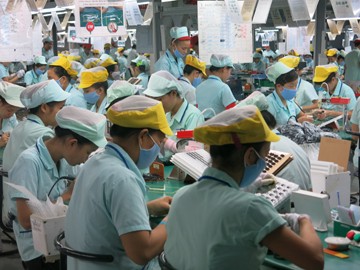
Vietnam’s labor productivity is said to remain lower than several other countries in the region.
Recent statistics from the International Labor Organization indicate that Vietnam’s labor productivity is still low.
The agricultural sector has a low added value growth and accounts for only 18.4% of Vietnam’s GDP while using 47% of its labor force.
Part of the problem is that science research and application and technology renovation in production remain restricted. Only 20% of the workforce are technically trained.
To comprehensively develop a qualified workforce for Vietnam, vocational training needs to more efficiently match market and social needs. Policies should encourage firms to conduct their own vocational training for their workers and increase cooperation with outside training facilities.
Dong Van Ngoc, the Rector of the Hanoi Electrical Mechanics College, says: “businesses should work closely with educational facilities in training. In other words, we should have a good strategy for using human resources and design a training curriculum which can be applied to many firms. And more job opportunities should be given to students. Right now we have to actively search for companies.”
Since 2012 a national program has been implemented to improve productivity and the quality of goods and products of Vietnamese enterprises until 2020. The program focuses on productivity, helping businesses apply advanced technology, and attracting domestic and foreign investors to the production of high-tech and auxiliary products. Nguyen Anh Tuan, Director of the Productivity Institute of the General Directorate for Standards and Quality, comments: “for projects of the Ministry of Science and Technology, we have recently developed approximately 200 models that apply advanced management techniques to improve productivity and reduce time, costs, and waste. These solutions have helped enterprises achieve productivity gains of up to 20%. We’ve helped 500 businesses apply these solutions.”
Tuan noted that to increase overall labour productivity, it’s important to increase the productivity of each economic sector: agriculture, industry – construction, and services.
To this end, the Prime Minister has approved a project to build 45 high-quality vocational schools by 2020. Other adopted policies will boost investment in key sectors, with particular focus on the support industry.
Other key goals are to help domestic enterprises upgrade their technology, lure more investment to rural areas to restructure rural labor, and most importantly – leverage the mechanism and the private economy to improve Vietnam’s business and investment environment, labor productivity, and competitiveness.